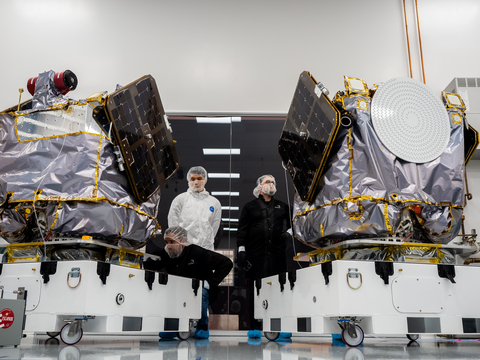Rocket Lab Ships Twin Satellites to Launch Site for NASA Mars Mission

Rocket Lab built ESCAPADE twin spacecraft fully assembled and ready for shipping at the company's Spacecraft Production Complex and headquarters in
The spacecraft, known as Blue and Gold, recently completed comprehensive assembly, integration, and test at Rocket Lab’s Spacecraft Production Complex and headquarters in
Upon arrival at NASA’s
“We’ve already been to the Moon for NASA, so we’re excited to build on that and send Rocket Lab technology deeper into the solar system, this time to the Red Planet,” said Rocket Lab founder and CEO Sir Peter Beck. “Our Space Systems team has built a beautiful and highly capable pair of spacecraft to help NASA and the University of California Berkeley further humanity’s understanding of Mars. We couldn’t be prouder to be an ESCAPADE mission partner enabling science and exploration missions beyond our planet. After a meticulous but speedy build and test phase, we’re excited to have Blue and Gold on their way to the Cape and a step closer to Mars.”
"The successful delivery of the spacecraft to
Once launched, the ESCAPADE mission will measure plasma and magnetic fields around the Red Planet. These observations will help scientists unravel the processes that strip atoms from Mars’ magnetosphere and upper atmosphere, offering critical insights into Martian climate evolution.
Images: https://www.flickr.com/photos/rocketlab/albums/72177720319488550
More info: https://www.rocketlabusa.com/missions/escapade/
+ About the ESCAPADE Mission
NASA’s ESCAPADE is a NASA heliophysics mission that will study Mars’ magnetosphere – the magnetized area of space around the planet – using two identical small spacecraft, which will provide simultaneous two-point observations. The spacecraft will help provide researchers a better understanding of how the magnetosphere interacts with the solar wind, and how energy and plasma enter and leave the magnetosphere. ESCAPADE is part of the NASA Small Innovative Missions for Planetary Exploration program. The mission is managed by the University of California Berkley’s Space Sciences Laboratory, with key partners Rocket Lab, NASA Goddard Space Flight Center, Embry Riddle Aeronautical University, Advanced Space LLC and Blue Origin.
+ About Rocket Lab
Rocket Lab is a global leader in launch and space systems. Rocket Lab’s Electron launch vehicle is the second most frequently launched
+ Forward Looking Statements
This press release contains forward-looking statements within the meaning of the Private Securities Litigation Reform Act of 1995. We intend such forward-looking statements to be covered by the safe harbor provisions for forward looking statements contained in Section 27A of the Securities Act of 1933, as amended (the “Securities Act”) and Section 21E of the Securities Exchange Act of 1934, as amended (the “Exchange Act”). All statements contained in this press release other than statements of historical fact, including, without limitation, statements regarding our launch and space systems operations, launch schedule and window, safe and repeatable access to space, Neutron development, operational expansion and business strategy are forward-looking statements. The words “believe,” “may,” “will,” “estimate,” “potential,” “continue,” “anticipate,” “intend,” “expect,” “strategy,” “future,” “could,” “would,” “project,” “plan,” “target,” and similar expressions are intended to identify forward-looking statements, though not all forward-looking statements use these words or expressions. These statements are neither promises nor guarantees, but involve known and unknown risks, uncertainties and other important factors that may cause our actual results, performance or achievements to be materially different from any future results, performance or achievements expressed or implied by the forward-looking statements, including but not limited to the factors, risks and uncertainties included in our Annual Report on Form 10-K for the fiscal year ended December 31, 2023, as such factors may be updated from time to time in our other filings with the Securities and Exchange Commission (the “SEC”), accessible on the SEC’s website at www.sec.gov and the Investor Relations section of our website at www.rocketlabusa.com, which could cause our actual results to differ materially from those indicated by the forward-looking statements made in this press release. Any such forward-looking statements represent management’s estimates as of the date of this press release. While we may elect to update such forward-looking statements at some point in the future, we disclaim any obligation to do so, even if subsequent events cause our views to change.
View source version on businesswire.com: https://www.businesswire.com/news/home/20240816684891/en/
Rocket Lab Media Contact
Lindsay McLaurin
media@rocketlabusa.com
Source: Rocket Lab USA, Inc.








